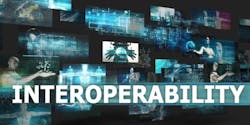I am one of those who have touted HL7 FHIR’s potential to solve some of the industry’s interoperability woes. But is focusing on FHIR like starting to build a skyscraper on the third floor? That’s what Keith Campbell, director of informatics architecture at the U.S. Veterans Health Administration, argues. His focus — on the ground floor — is semantic interoperability so that health systems don’t have to keep creating maps between different terminologies.
FHIR provides a level of interoperability for APIs and consumption of transports that is way beyond where HL7 v3 was, so in some regards you can’t sing high enough praises of FHIR, Campbell said in a recent interview. “But some people feel it solves all the problems. It doesn’t solve the semantic interoperability problem. It solves a problem of how do I open a socket and how do I send a standard resource.”
In July 2016 I wrote a news story about the nonprofit Healthcare Services Platform Consortium’s sponsorship of an open source effort to improve semantic interoperability between SNOMED, LOINC and RxNorm with a project called SOLOR (SnOmed LOinc, Rxnorm). Now the project, which Campbell is leading, is mature enough that HSPC is opening the doors to developers to collaborate on SOLOR.
I asked Campbell to describe the problem SOLOR is trying to solve. He explained that SNOMED, LOINC and RxNorm are important Meaningful Use standards, but where there is overlap and no clean separation of concerns, each health system has to map how data elements are defined in their respective EHRs to these standard terminologies, which leads to great difficulty in sharing things like clinical decision support modules across health systems such as between the VA and the Department of Defense.
“The VA has a desire to try to make things simpler,” Campbell said. “It is just too complicated today. We have seen issues related to how data is managed in the industry that have brought harm to veterans, quite frankly. And yet it just seems to be an accepted status quo. That is one of the things we are trying to push with SOLOR.”
He said they sought to come up with a moniker that was acceptable and put everyone on equal standing with regard to recognition of their unique contributions. The goal is not to get LOINC to go away in preference of SNOMED or to get SNOMED to go away in preference of LOINC. “We are really just trying to make it all work,” he said. “These are really important Meaningful Use standards, yet pulling them all together is an exercise left to the end user.”
Campbell stressed that the problem is not unique to the VA and DoD. “Let’s say the VA was trying to do a data-sharing initiative with Kaiser Permanente, so veterans could choose to have their care in the private sector,” he said. “If we wanted to exchange data, we would have to go through a very similar mapping exercise with any private care partner. This is a problem in the industry.”
If through these integrations and mappings, you fail to identify things that should be equivalent, he said, it has potential consequences that are as serious as any other medical complication.
Besides the consequences for patient safety, there are hindrances to being able to establish an industry, he noted. “If you can’t create a knowledge support or decision support product that can go from organization to organization with fairly low friction of adoption, that is a problem in my book.” He said if people implement the common foundation of SOLOR, then decision support vendors wouldn’t have to depend on a custom one-off integration with an enterprise’s unique interpretation of Meaningful Use standards.
Semantic data interoperability is a complicated topic, and how SOLOR works gets pretty technical. For those interested, there is a white paper on the SOLOR website that goes into detail. It is described as a way to integrate terminology content in a single model. As its web site states, it uses a common model in which the integrated terminologies are transformed. “During transformation, the content from one or more terminologies populate the common model. Each SOLOR data element retains the original identifiers and additionally provides a common UUID (universally unique identifier)- based identifier.” A SOLOR Viewer app will allow a user to import, transform, and view SNOMED, LOINC, and RxNorm in SOLOR’s common model.
“We are getting mature enough and getting enough consensus that we are opening the doors for other people to collaborate and work on it,” Campbell said. “Our goal is that within a year we would have something that is of equivalent quality to what people are actually using in practice today. Within the VA, we would be working to push it into production systems and also make it available so that others can contribute to it and make their own choices about whether they want to continue with a proprietary mapping process or whether to go more with an integrated terminology model with a standard extension model.”
I asked Campbell if EHR vendors would be leaders or followers in this effort. “If semantic interoperability were really important to the large EHR vendors, you would think they would have solved that problem up front,” he said. “They get no revenue from solving the data interoperability problem.”
He believes the big health delivery organizations that are moving to value-based care will ultimately make the difference. “Part of getting better value out of their data,” he said, “is having it be better normalized.”


